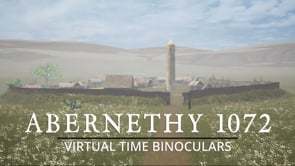Abernethy 1072
Dublin Core
Title
Abernethy 1072
Description
In 1072 the small Scottish village of Abernethy was the site of a meeting between the King of Scots, Malcolm Canmore, and William of Normandy (who had recently conquered England). In a show of force William brought a fleet of ships up the River Tay, and Malcolm made an oath of loyalty to the English ruler. Exactly what Malcolm believed he was promising is still debated by historians.
At this time Abernethy was an important religious centre, and home to a community of Culdees or Céli Dé (which means ‘client of God’ in Gaelic). The Culdees were Christian holy men who followed a form of religious life developed in Ireland during the Early Middle Ages.
Today Abernethy is famous for its tall early medieval round tower – an extraordinary survival from the time of the Culdees. There is only one other tower of this type in Scotland (at Brechin Cathedral), although they are more common in Ireland. The tower probably served as a bell tower and treasury.
This reconstruction represents how Abernethy may have looked in the 1070s. It shows the tower, church, and dwellings of the Culdees and their tenants. It was created by the University of St Andrews and Smart History, in collaboration with the Tay Landscape Partnership and Perth and Kinross Heritage Trust. The reconstruction was inspired by the study of the extant round tower and its surroundings, and comparison with early monastic sites in Ireland (including Downpatrick, Devenish, and Glendalough).
An interactive virtual reality version of the reconstruction can be explored at the Museum of Abernethy, School Wynd, Abernethy, Perthshire, PH2 9JJ.
Contributor
eulac3d
Format
video/mp4
Type
Moving Image
Europeana
Object
https://player.vimeo.com/video/331193784
Europeana Type
VIDEO
Moving Image Item Type Metadata
DescriptionEN
In 1072 the small Scottish village of Abernethy was the site of a meeting between the King of Scots, Malcolm Canmore, and William of Normandy (who had recently conquered England). In a show of force William brought a fleet of ships up the River Tay, and Malcolm made an oath of loyalty to the English ruler. Exactly what Malcolm believed he was promising is still debated by historians.
At this time Abernethy was an important religious centre, and home to a community of Culdees or Céli Dé (which means ‘client of God’ in Gaelic). The Culdees were Christian holy men who followed a form of religious life developed in Ireland during the Early Middle Ages.
Today Abernethy is famous for its tall early medieval round tower – an extraordinary survival from the time of the Culdees. There is only one other tower of this type in Scotland (at Brechin Cathedral), although they are more common in Ireland. The tower probably served as a bell tower and treasury.
This reconstruction represents how Abernethy may have looked in the 1070s. It shows the tower, church, and dwellings of the Culdees and their tenants. It was created by the University of St Andrews and Smart History, in collaboration with the Tay Landscape Partnership and Perth and Kinross Heritage Trust. The reconstruction was inspired by the study of the extant round tower and its surroundings, and comparison with early monastic sites in Ireland (including Downpatrick, Devenish, and Glendalough).
An interactive virtual reality version of the reconstruction can be explored at the Museum of Abernethy, School Wynd, Abernethy, Perthshire, PH2 9JJ.
Collection
Citation
“Abernethy 1072,” Digital Open Doors, accessed December 13, 2025, https://ddo.openvirtualworlds.org/omeka/items/show/4087.
Embed
Copy the code below into your web page
